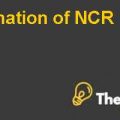
Yokohama Corporation, Ltd. (A)
1. According to the case material, Yokohama's profits declined from $9 billion in 1986 to $4 billion in 1991. Explain why profits declined during this period. How did the firm expect to turn around its profitability? (15 marks)
Reason of declined Profits
Yokohama's profits declined from $9 billion in 1986 to $4 billion in 1991. This is because of numerous reasons that combined together and resulted in a decline in profits.
Intense Competition
The market in which Yokohama existed was highly competitive. In such a market companies make their place on the basis of their competency and the competitive advantage that it gains over time. However, this was not possible in the case of Yokohama. It is because companies were using replicable technologies. Thus, companies could not achieve sustainable competitive advantages.
Even if companies developed a better technology, they could not hide it from other competitors because of the nature of the industry. The inability of firms to maintain any real degree of technological leadership for a long time affected the company’s profitability.
High Bargaining Power of Customer
Since the competition is high in this industry, the bargaining power of customers is also very high. Companies frequently entered into price wars to retain and attract new customers, which caused the reduced margins for the company. Customers had access to costing systems of every supplier and the switching cost for them was extremely low. Customers contacted multiple suppliers to complete their tasks. Along with that, they compared prices and offered an even lower price that was called the target costing system. This did not leave many margins for companies. As a result, the profitability of companies in this industry declined drastically.
Contraction in Product Life Expectancy
Usually the R&D cost is recovered by the company over a long period of time. It is considered a fixed cost, thus the impact is spread over a longer time period. Since the life of product has reduced, it has to be covered in a shorter period of time, which means that the cost will have to be recovered by fewer units. The price pressure will not let the product’s price rise above so the R&D cost will reduce margins with even higher intensity.
Design Activities
Initially, customers used to design the product and convey it to the supplier. The customer used to provide product specifications. Later on, they delegated the task of designing to suppliers. Hence, the development cost of the company increased. The product design and manufacturing became the responsibility of engineers.
Turn Around the Profitability
Yokohama implemented a three stage process to revive back its profitability position. It was very important for the company to reduce the cost and find some way to increase its revenues. For this purpose, the first step taken by the company was that efforts in planning and designing were increased so that the impact on cost can be reduced by investing less in the R&D.
Another step that the company took was that it approached its customers and proposed new approaches to the design, manufacture and processing of existing products. Thus the impact of the shifted responsibility of designing the product and investing the money on new designs will be reduced. This was an efficient way through which the task of designing became a contribution of both the parties and the old product that had already eaten up a lot of R&D cost was being utilized.
The third and most important step taken by the company was to ensure bulk production in order to achieve economies of scale. Yokohama analyzed its competencies and identified new products that it could produce at competitively low costs. Then, it started bidding for that product in an aggressive manner. Therefore, the company can buy the raw material in bulk and take the discount advantage. From the analysis, the company’s management decided to avoid the launch of any product that is not expected to generate acceptable margins in its life time.
By taking these steps, Yokohama expected to turn around its profitability. The implementation of this plan was not easy and it would not have been successful in an industry where the risk of losing a potential customer is high. However, in this industry the nature of work is very different. Thus, this strategy seemed very beneficial for increasing the profitability position of the company.
2. Many of Yokohama's customers used target costing systems to set prices at which they were willing to purchase products:
Critically evaluate Yokohama's customers' use of their target costing systems. (10 marks)
Yokohama operated in business to business transactions. In this type of transaction, generally the number of customers is low but size of customers (in terms of number of units bought) is high. Hence, the customer’s power increases because a single customer can affect the company’s profit to a large extent.
Along with that, customers used more than one supplier to complete their orders. Customers have an idea that number of suppliers in the market is high and they all are aggressively competing against each other. The product differentiation is not much. So they can pressurize suppliers on price of the product.
Moreover, Yokohama had to considerably share the information with its customers so they had a clear idea about the cost that the company is paying for the production of that part. If the product cost of the part is reduced by innovative means, then the target price would be adjusted by the customer. As a result, the margin of the company could not be increased.
Customers also used to work with multiple suppliers. Thus, if one supplier is able to provide the product at a lower cost then it expected other suppliers to reduce prices as well, since that company was not able to reduce its costs, it had to compromise on its margin to remain the supplier of the company and maintain the competition.........
This is just a sample partial case solution. Please place the order on the website to order your own originally done case solution.
The solution will also come with a separate excel file with calculations.












